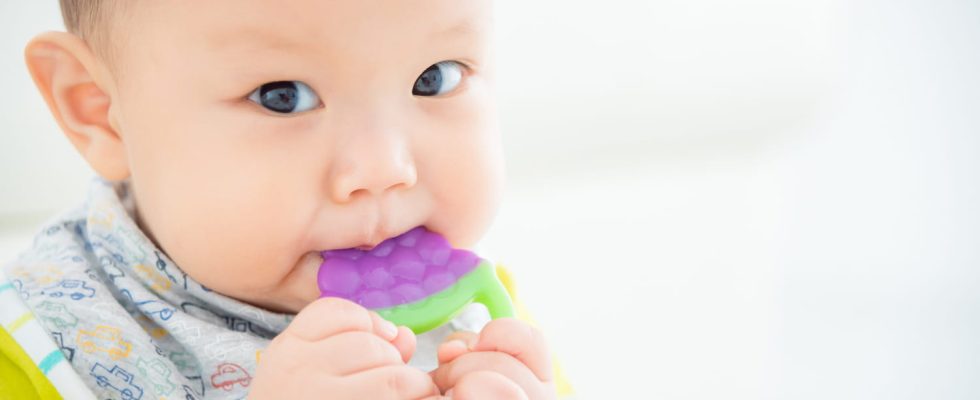Red buttocks and cheeks, baby drools, he nibbles everything he finds… He is teething! What are the other symptoms of teething? At what age do teeth break through the gums? How to soothe pain and relieve baby? Advice from Dr. Jona Andersen, pediatric dentist.
Teething usually happens around 6 months of baby. and can sometimes be accompanied by pain and fever. In the event of teething, babies will tend to chew on all their objects, salivate profusely, and will sometimes be irritable. Teething often causes flushed cheeks and diaper rash (red buttocks). So, how to relieve your baby? How long does teething last? Here is the advice of Dr. Jona Andersen, dental surgeon specializing in pediatric dentistry.
At what age does a baby have teething?
Some babies have teeth that grow very earlyothers later… teethingthat is, when the deciduous teeth set up, is generally done around the 6 months of the child.
What is teething?
Teething is when baby teeth begin to break through the gum line to grow. During the first two years, the child will see his twenty milk teeth appear successively.
What are the symptoms of teething in babies?
The movement of the teeth in the jaw bone and the breakthrough at the gums can be very painful for the child who can be “irritable or restless, crying or even, having less appetite and disturbed sleep“. In addition, a child who is teething may have:
- of the moderate fever,
- have red and irritated buttocks (called diaper rash),
- salivate profusely, drool,
- to have some sore gums, swollen or even swollen,
- red cheeks,
- loose stools that look like diarrhea…
- The child will also tend to putting fingers or objects in mouth in order to rub the areas that hurt him.
- If your child has a fever, you can give him an analgesic (paracetamol specially dosed for babies) on medical advice.
- In parallel, regularly massage his gums with a clean finger or a clean, damp cloth.
- To “numb the pain”, the chilled rings relieve (place a teething ring in the refrigerator 20 to 30 minutes before giving it to your child)
- THE homeopathic gels can also soothe the pain. To do this, wash your hands, take a small dab of gel (such as Hyalugel 1st teeth, Pansoral 1st teeth) and gently massage your baby’s gums – 3 to 6 times a day, after meals and before bedtime – until until the affected area is completely covered.
- Don’t forget to wipe your face regularly with a clean cloth to prevent irritation due to excess saliva from appearing.
- Offer him fresh food like compotes or a banana.
“I strongly advise against anesthetic gels sold in pharmacies to relieve pain due to teething”.
What to do in case of late teething?
“Remember to consult if there are no apparent teeth at the age of one year”
The age of teething varies greatly from baby to baby. “However, if your baby has no teeth at the age of one year, it is advisable to consult. This is not necessarily worrying, but it is important to determine the cause of a late teething and to follow the evolution of the dentition“, reassures the specialist.
SO, how to explain that a teething is so late? The pediatrician or the dentist will then examine your child’s mouth and see if it is a simple delay in teething, growth retardation, a problem in feeding or a pathology linked to a genetic disease, which is still very rare. In addition, thanks to a dental x-ray, he will be able to see if he is possibly missing one or two milk teeth. If the teeth are slow to come out, the best thing is to offer him a diversified diet, while continuing to mix and grind the food.
What to avoid when teething
Faced with teething, it is strongly advised not to:
- try to pierce the child’s gum to help the tooth come out at the risk of causing an infection.
- Amber necklaces and sugary teething cookies are also to be avoided.
- No product such as alcohol, aspirin or anesthetic gel should be applied to the child’s gums.
